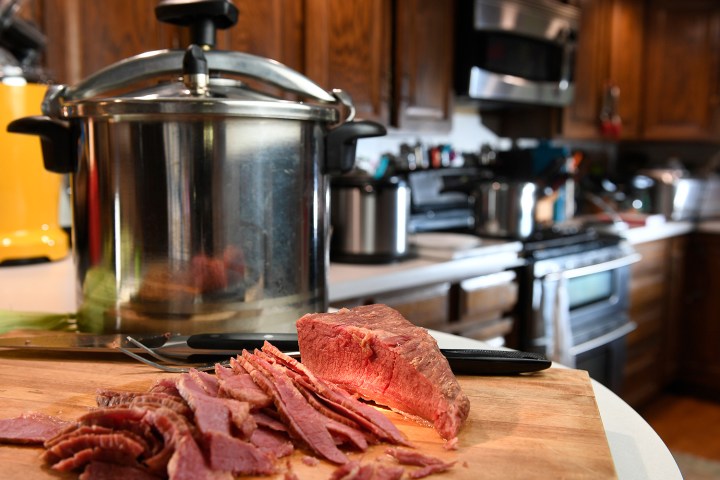
Whether you have a stovetop cooker or an electric stand-alone pressure or multicooker, it works pretty much the same. Pressure cookers include a sealed pot that builds up steam pressure, which allows for faster cooking. The cooker contains a valve that helps control and release the steam pressure. Many devices also contain some sort of gauge to help you determine the level of pressure you’ve accumulated in the pot. This steam pressure is trapped inside the pot, and has nowhere to go but in your food. Because pressure cooking adds moisture into your food, tougher meats like roasts become more tender when you prepare them in a pressure cooker.
Most meats — chicken, pot roast, and even ground beef — typically cook nicely under pressure. Your veggies and potatoes will also pressure cook pretty well. You can even prepare certain dessert foods (like cheesecake or custard) using pressure. In fact, pressure cooker cheesecake seldom sinks in the middle, and it often comes out better than when you bake it in the oven.
On the other hand, some foods are not meant for your pressure cooker. If you try to cook these foods in a pressure cooker, you could ruin your machine, ruin your meal, risk fire or injury, or make someone sick.
Noodles
Although you may often see pressure recipes for foods like macaroni and cheese, you should shy away from cooking noodles in your pressure cooker. According to the Farberware owner’s manual for its 8-quart stovetop pot and several other manufacturer warnings, foods like noodles can foam, froth, or sputter, which can clog the pressure release valve and lead to excessive pressure build up.
Sure, most modern pressure cookers have backup pressure release mechanisms. But, have you seen the videos of exploding pressure cookers on YouTube?
The Farberware manual warns that these foods can also cause the same (excess pressure) problem:
- Applesauce
- Cranberries
- Pearl barley
- Oatmeal (other cereals)
- Split peas
- Rhubarb
Multiple types of ingredients at the same time
Some cooks make the mistake of adding all of the ingredients to the pressure pot simultaneously, and cooking them together. They may even think that the food will come out prepared, as long as they set the timer to however long the meat portion of the recipe is supposed to take. However, when you’re preparing recipes that contain multiple types of ingredients (like meat and potatoes), it’s best to prepare each individual ingredient separately, or add them to the pot in order of their required cooking times.
The times in the chart below come from the owner’s manual for the Fagor Duo Stovetop Pressure Cooker. You’ll notice the vast difference in cooking times across the various ingredients.
| Food | Estimated cooking time | Pressure level |
| Blueberries | 8-10 minutes | High |
| Apples (fresh slices) | 2-3 minutes | High |
| Red potatoes (sliced) | 6 minutes | High |
| Corn on the cob | 3 minutes | High |
| Peas in the pod | 1 minute | High |
| Zucchini (sliced) | 8 minutes | High |
| Lamb, leg | 35-40 minutes | High |
| Pork roast | 40-45 minutes | High |
| Chicken (whole 2-3 pounds) | 12-18 minutes | High |
If you cook corn, potatoes, and lamb at the same time, you may end up with overcooked vegetables or undercooked meat. Pay careful attention to the recipe instructions and the order in which you should add ingredients. Also, double check your recipes against your owner’s manual to make sure the times and quantities make sense, and that the recipe accounts for cooking time differences between ingredients.
It’s also wise to make sure you don’t overstuff your pressure cooker with too much food. As a general rule you should not fill your pressure cooker more than half-way full with foods that expand during cooking (like rice). For foods that don’t expand too much, avoid filling your pressure device more than two-thirds of the way full.
Delicate, crispy, or fried foods
Remember, pressure cookers add moisture to your food to cook it. Therefore, dry and crispy foods like potato chips or popcorn may not turn out so well if you cook them in steam (soggy popcorn, yuck!). The same goes for light and fluffy pastries and certain types delicate fish, like flounder.
Deep frying in a pressure cooker is not the best idea either. You could literally end up playing with fire, and no fried chicken is delicious enough to be worth the risk.


